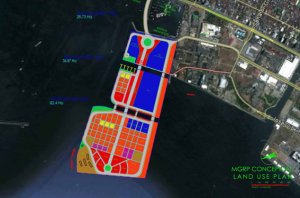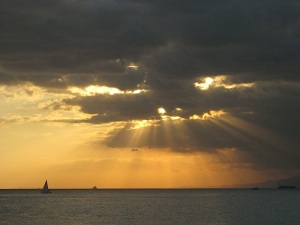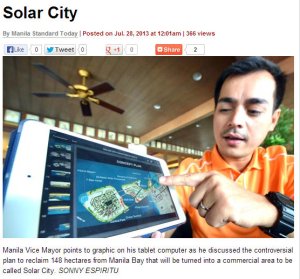
The Manila Solar City is a proposed joint reclamation project of the Manila City Government and the Manila Goldcoast Development Project
The Manila Solar City is a proposed reclamation project that will be undertaken by the Manila City Government and the Manila Goldcoast Development Corporation.
The proposal is to reclaim 148 hectares of land located at the back of the Philippine Navy and Manila Yacht Club 600 meters towards the bay.
It will have a frontage of only 635 meters parallel to Roxas Boulevard, and occupying less than 0.082 percent of the bay’s 1800 sq. km. surface area.
Its boundary will be only up to the Ospital ng Maynila, a full kilometer from the US Embassy.
Just like the CCP complex, which includes the Philippine International Convention Center, Folk Arts Theater, Manila Film Center, Coconut Palace (which now houses the Office of Vice President), and Sofitel Hotel, the MGRP will not adversely affect the historic allure of the bay.
The proposed reclamation project will consist of three (3) reclaimed islands:
- East Island 1 which is closest to the Manila Yacht Club/ MYV (at 28.73 has.),
- East Island 2 (at 36.87 has.)
- West Island which is farthest from R-1 and MYC (at 82.40 has.)
Manila Solar City to Rise in Manila Bay
JULY 30, 2013 LEAVE A COMMENT
 MANILA, Philippines – A world-class commercial, residential and tourism center may soon rise in the middle of Manila Bay.
MANILA, Philippines – A world-class commercial, residential and tourism center may soon rise in the middle of Manila Bay.
Manila Solar City, which spans 148 hectares, is a reclamation project that will feature a park and a Boracay-inspired man-made beach. It will also have a terminal for international cruise ships, which are expected to bring between 2,500 to 5,000 tourists every week.
“That (Manila Solar City) will be a big boost to the Ermita area, surrounding areas,” Edmundo Lim, vice chairman of Manila GoldCoast Development Corp., said.
The developer said the project will create 100,000 jobs for construction workers. Once construction is completed, another 500,000 workers will be hired for operations.
“Right now, the study shows that Manila has the most number of jobless people. A hungry stomach knows no law. So we can eliminate criminality,” Manila Mayor Joseph Estrada said.
The developer said the government will earn P17 billion in tax revenues from the project every year. Some P10 billion worth of real estate taxes will go to Manila city government.
“This is one way of answering the fiscal situation of the city, wherein Mayor Erap iniwan sa kanya ang city na may P3.5 billion na utang,” Manila Vice Mayor Isko Moreno said.
But some environmental groups are opposed to the planned Manila Solar City.
“Reclamation has proven many times to cause flooding… Lalong babagal yun daloy ng tubig mula sa waterways ng Metro Manila papunta sa Manila Bay,” Ivan Henares, president of the Heritage Conservation Society Youth, said.
But Manila GoldCoast’s Lim said they will design Manila Solar City in a way that it will not cause flooding in the city.
“We’re going to make sure there’s no baha. We call it disaster-resilient. The way it’s designed (it) becomes like a breakwater yung mga storm surge nababawasan,” he said.
Despite environmental groups’ concerns, Estrada is optimistic the project will be approved by President Aquino.
City of Manila Looks to Bay Reclamation to Shore Up Revenues and Boost Tourism
JULY 28, 2013 1 COMMENT
 The City Council of Manila continues to support its joint venture project with the Manila Goldcoast Development Corporation that will lead to the construction of the Manila Solar City — a 148 hectares reclamation project at the back of the Philippine Navy and Manila Yacht Club 600 meters towards the bay.
The City Council of Manila continues to support its joint venture project with the Manila Goldcoast Development Corporation that will lead to the construction of the Manila Solar City — a 148 hectares reclamation project at the back of the Philippine Navy and Manila Yacht Club 600 meters towards the bay.
Manila Vice Mayor Isko Moreno led the City Council in reaffirming its support for the reclamation project which will provide an additional estimated P4 Billion in annual real estate taxes.
Moreover, the planned reclamation project is aimed at drawing more foreign tourists to Manila. Once built, the Manila Solar City will have a port facility for international luxury ship cruises and will link up Manila to luxury cruise tourism which is a multi-billion dollar tourism business.
Moreno disclosed recently in news reports that the City of Manila has outstanding debts amounting to P 3.5 Billion, hobbling the city’s capacity to provide services and pay for its bills.
The Vice Mayor also pointed out the imminent possibility of the City Hall becoming powerless, explaining that the Manila Electric Company was demanding payment for a P598 Million debt left by the previous city administration.
Opposition to the Manila Bay Reclamation project has ceased after the Court of Appeals junked a petition to stop another reclamation project south of the proposed site of Manila Solar City. The petition filed at the Court of Appeals posed arguments quite similar to the arguments raised by those protesting against the Manila Solar City.
In May, the Court of Appeals junked the petition filed by then senatorial candidate Cynthia Villar which was filed in March last year that sought to stop a Manila Bay reclamation project that could allegedly cause catastrophic flooding in Metro Manila.
In a 48-page decision penned by Associate Justice Apolinario Bruselas, the CA Third Division denied Villar’s plea against the Las Piñas-Parañaque Coastal Bay project for lack of merit and for failing to prove the reclamation project would trigger massive environmental damage.
“No credible, competent, and reliable evidence had been presented to support the allegations that the proposed coastal by project would cause environmental damage of such magnitude as to prejudice the lives, health or properties of the residents of Parañaque and Las Piñas. These apprehensions had been disproved by objective, expert and scientific studies of reputable entities with vast international experience,” the CA Division said.
The court said Villar failed to present evidence that would show a “causal link” between the project and the “catastrophic environmental damage feared (by the petitioner).”
“The credibility, reliability and objectivity of the scientific studies presented by respondent AllTech and the totality of the evidence presented leave very little occasion to ponder that the constitutional right of the people to a balanced and healthful ecology hangs in the balance because of the reclamation project,” the court added.
Justice Rebecca De Guia-Salvador and Samuel Gaerlan concurred with the decision of Bruselas.
Manila Solar City Gets Support from Former President Now Manila Mayor Joseph “Erap” Ejercito Estrada
JULY 27, 2013 2 COMMENTS
 Former President now Manila Mayor Joseph “Erap” Ejercito Estrada faces the challenges of ridding his city of debt amounting to P3.5 Billion and reviving the once thriving tourism industry of the capital city.
Former President now Manila Mayor Joseph “Erap” Ejercito Estrada faces the challenges of ridding his city of debt amounting to P3.5 Billion and reviving the once thriving tourism industry of the capital city.
Proving, yet again, his mettle as the leader who laid the foundation of San Juan’s Cityhood, Estrada has reportedly put his support behind the proposed Manila Solar City Reclamation project.
As a joint venture between the City of Manila and the Manila Goldcoast Development Corporation, the Manila Solar City Reclamation project is expected to generate more than P9 Billion in real estate taxes alone and create about 200,000 new jobs.
The reclamation project, which substantially increases the viewing space for Manila Bay’s world famed sunset, will not only be built at little cost to the cash-strapped city government but also prop up its present and near future revenue earnings.
Once completely built, the Manila Solar City will have docking facilities for international luxury cruise ships, connecting the Philippines to a multi-billion dollar Asian region tourism industry.
According to the website Red Luxury Asian luxury cruises are bound for the up and up:
Pier Luigi Foschi, Carnival Corporation’s Head of Asia, predicts that Asian passengers will account for one in every five cruisers, or about double the ratio today, by the end of the decade. He expects Asia will be able to supply 3.7 million passengers a year by 2017 and 7 million passengers a year by 2020.
Together with the docking facility for international luxury cruises, Manila Solar City is planned to have an extensive center for Philippine culture and arts. From the classical to the currently popular, Manila Solar City has in its plans a number of performance venues as well as museums, galleries, and exhibition centers that will highlight the best of Philippine culture and entertainment.
Wilson Tieng, the President and CEO of Manila Goldcoast Development Corporation, intimated that Filipino sculptors and other visual artists have already been consulted on designs for monuments and installations depicting heroes of Manila and the Philippines.
MGDC promises to build destination attractions that will bring in foreign and local tourists just as world-class structures like the Petronas Towers in Malaysia, The Burj Dubai, the London Eye (a giant Ferris Wheel in London) have become destination attractions in other countries. If MGDC can do that, this will make Manila a must-visit tourist destination for the whole world.
The Manila Solar City is not only intended to realize a grand vision of Manila Bay as the country’s front door to the world (a vision articulated by world renowned architect and urban planner Jun Palafox), but also help the 500 year old capital city withstand the onslaught of climate change.
During the Dredging and Land Reclamation 2012 Conference in October 2012 in Singapore, Palafox made this statement: “The reclaiming of a big portion of Manila Bay could reduce Metro Manila’s vulnerability to flooding even during heavy rains and high tides. The Philippines has the third longest waterfront in the world but we don’t use our waterfront as front doors to development.”
He told the conference that this practice has proven to be effective in many parts of the world. Reclamation reduces flooding. Someone who agrees with this is Leo Jasareno, chief of the Mines and Geodetic Bureau (MGB) who sees the reclamation of parts of Manila Bay as a way of mitigating the effects of climate change on the environment.
Palafox is the urban planner of Dubai. Under Palafox, Dubai expanded its waterfront from its original 70 to 2,000 kilometers through reclamation.
No comments:
Post a Comment